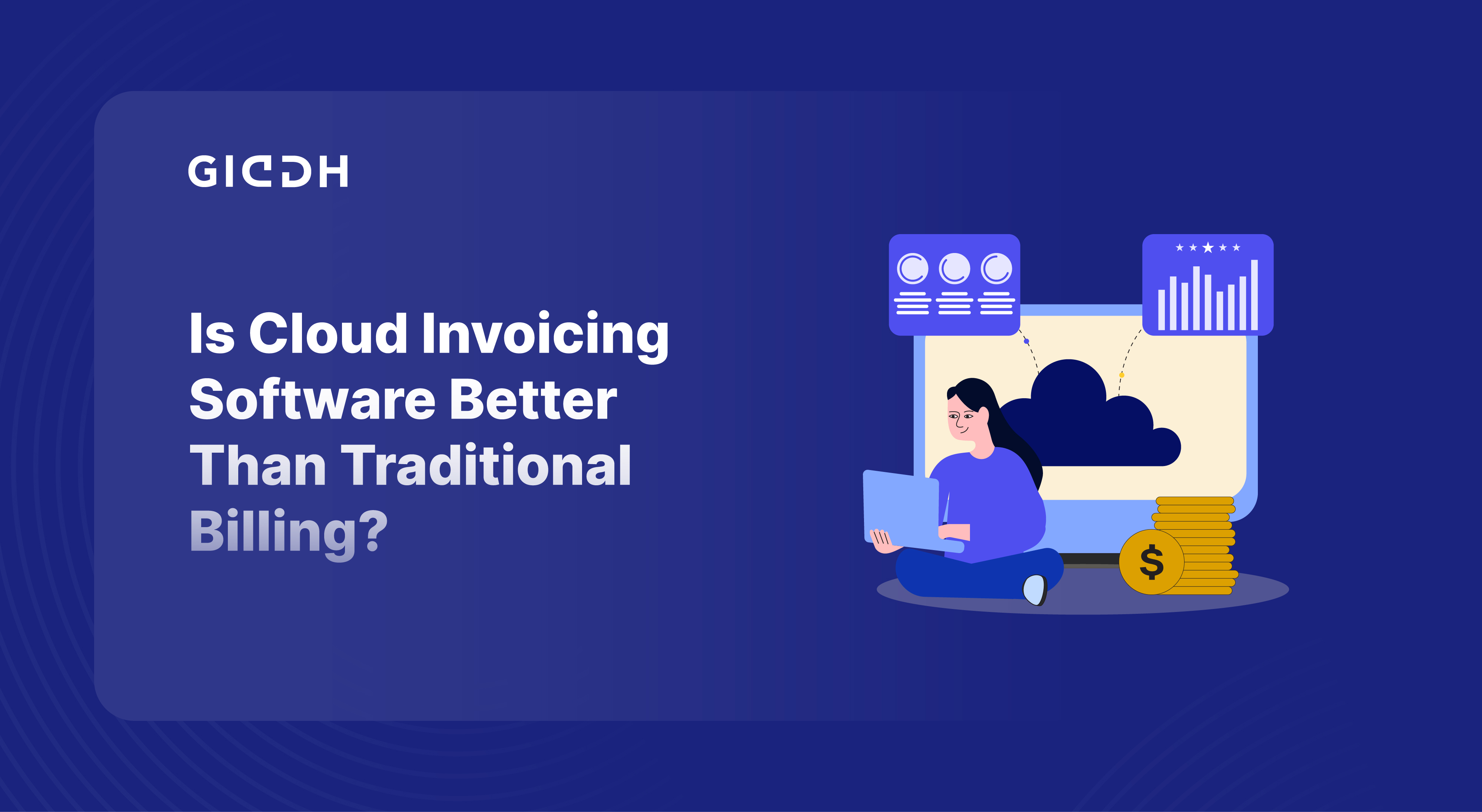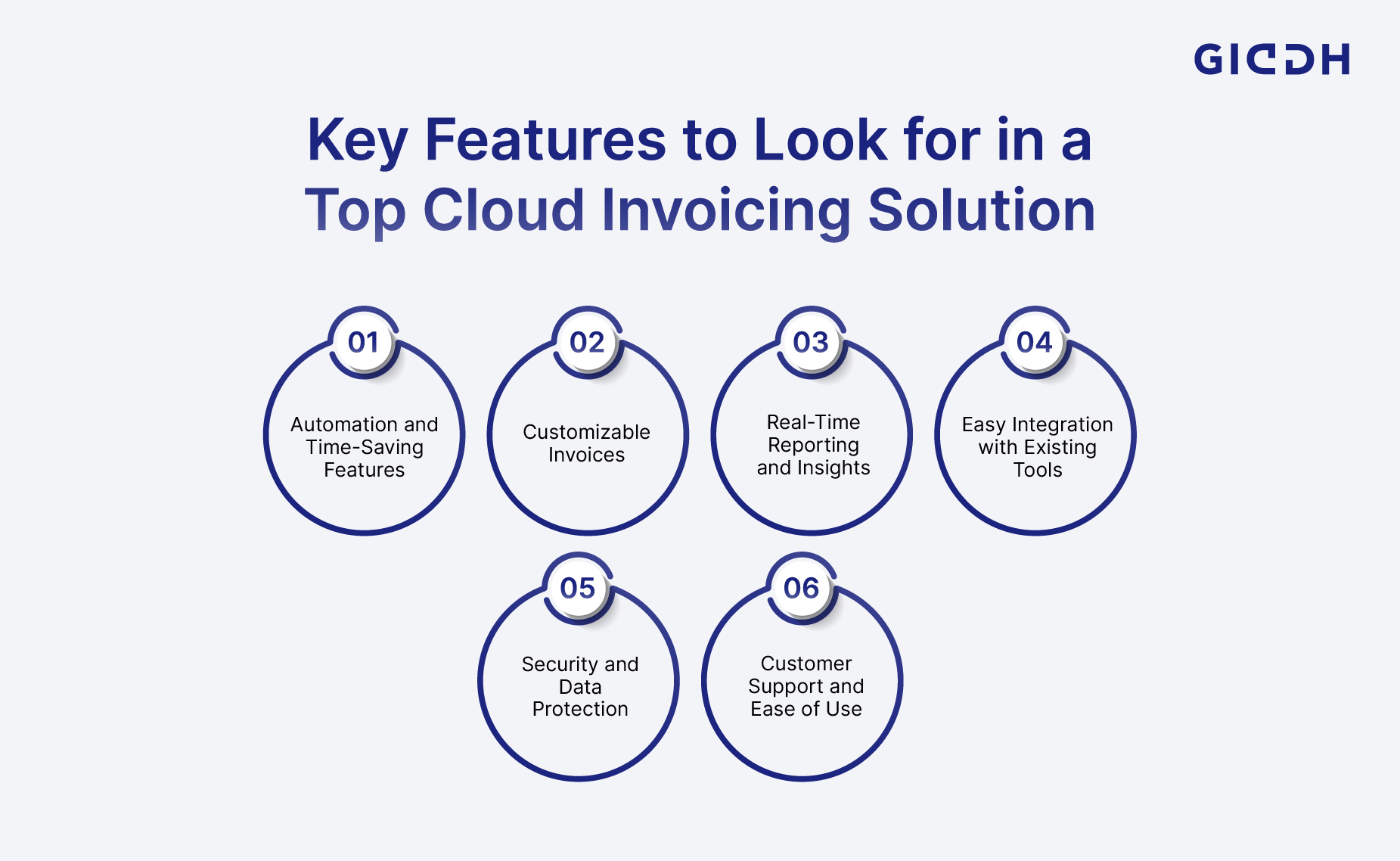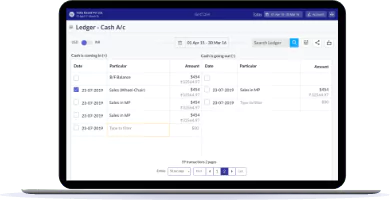Cloud Invoicing vs Traditional Billing - Which Works Best for Business?

Did you know that, on average, a small business receives payments eight days later than agreed, simply because its billing process is inefficient? For many growing companies and financial managers, these delays and errors aren’t mere annoyances—they’re tangible drains on cash flow, time, and productivity.
If your team still handles invoicing manually, tracks paperwork, and chases payments by email, you’re likely facing inefficiencies that slow revenue and add costs. That’s where cloud invoicing software and, by extension, online invoicing software and cloud‑based billing solutions can make a difference.
This post will walk you through cloud invoicing software vs traditional invoicing, how cloud invoicing improves billing efficiency, and what those benefits look like for a business like yours.
What Are The Core Advantages Of Cloud Invoicing Software?
When you move to cloud invoicing software (or online invoicing software / cloud‑based billing solutions), you lose several operational and strategic advantages.
Automation of invoicing
-
The system can automatically generate and send invoices based on predefined templates and rules.
-
Automatic reminders for overdue invoices reduce the need for manual follow‑up.
-
Manual errors drop—and labour hours shrink.
Accelerated payment cycles
-
With digital delivery and optional payment links, you reduce the time between invoice issuance and receipt of funds.
-
Automated reminders and reconciliation save your team from repetitive tasks.
-
Faster cash flow improves your working capital and flexibility.
Real‑time financial insights
-
You gain live dashboards showing: issued invoices, overdue payments, and cash flow projections.
-
That visibility lets you respond faster to payment risks, spot trends, and make smarter decisions.
-
When you know “who owes what and when”, you’re not flying blind.
Scalability & flexibility
-
As your business grows, so does invoice volume; cloud systems scale without linear increases in manual workload.
-
Remote access lets you manage billing from anywhere—ideal for freelancers or distributed teams.
-
Integration with other systems (CRM, accounting) becomes possible, reducing silos.
Cost‑effectiveness
-
You often pay a subscription rather than build expensive infrastructure.
-
Automation minimises wasted labour and error costs (some studies report up to 80 % cost cut for automated invoice processing).
-
With fewer delays and errors, you boost cas,h flow, and that’s a direct business benefit.
What Features Should You Look For In A Top Cloud Invoicing Solution?

When choosing a cloud invoicing solution for your business, it's essential to ensure the software you select provides a range of features that improve efficiency, streamline processes, and offer ease of use. Here are the key features to look for in a top-tier cloud invoicing solution:
Automation and Time-Saving Features
The primary benefit of a cloud invoicing solution is automation. A top solution will allow you to automate key tasks like invoice generation, sending, reminders for overdue payments, and even recurring billing. Automation saves your business time by eliminating manual tasks and reducing the chances of human error.
-
Automated invoice creation for recurring clients.
-
Automatic payment reminders for overdue invoices.
-
Recurring billing options for subscription-based businesses.
-
Invoice tracking enables real-time status monitoring.
Customizable Invoices
Customisation is crucial to ensure your invoices accurately reflect your brand and include all relevant business details. A sound cloud invoicing system lets you customise the look and feel of your invoices, adding your logo, business information, payment terms, and specific line items.
-
Custom templates to match your business branding.
-
Ability to add logos, payment terms, and custom fields.
-
Flexible design options to suit your business needs.
-
Multi-currency accounting support for international businesses.
Real-Time Reporting and Insights
A key benefit of cloud invoicing software is its ability to provide real-time financial insights. Look for software that offers easy-to-read dashboards and detailed reports on outstanding invoices, overdue payments, and cash flow projections. These features allow you to make timely decisions based on the latest data.
-
Real-time dashboards for viewing outstanding invoices.
-
Detailed reports on cash flow, overdue invoices, and payments.
-
Data-driven insights for smarter decision-making.
-
Financial forecasting to help you plan for future growth.
Easy Integration with Existing Tools
Your invoicing software should seamlessly integrate with the other tools your business uses, such as accounting software, CRM, and payment gateways. Integration eliminates the need for duplicate data entry and helps streamline your entire workflow. This ensures that your financial records are accurate and up-to-date across all platforms.
-
Seamless integration with accounting software (e.g., Giddh, QuickBooks, Xero).
-
Syncs with CRM systems for easy client management.
-
Direct payment gateway integration to process payments efficiently.
-
Automated data syncing to avoid double data entry and errors.
Security and Data Protection
Since invoices contain sensitive financial data, security should be a top priority. Choose a cloud invoicing solution with strong encryption, secure cloud hosting, and backup systems. This protects your financial data from unauthorised access or loss. Also, check if the software complies with data privacy regulations to ensure your business remains compliant.
-
End-to-end encryption to protect invoice data.
-
Regular backups to prevent data loss.
-
Role-based access control for data security.
-
Compliance with local data privacy regulations (e.g., GDPR).
Customer Support and Ease of Use
Lastly, ensure the cloud invoicing solution is user-friendly, with intuitive navigation and easy setup. If issues arise, having reliable customer support through chat, email, or phone is essential. The software should be accessible and easy for you and your team to adopt, with no steep learning curve.
-
User-friendly interface with simple navigation.
-
Mobile app support for invoicing on the go.
-
24/7 customer support for addressing issues promptly.
-
Training resources to help you get up and running quickly.
How Giddh’s Cloud Invoicing Simplifies What Traditional Billing Complicates
Managing invoices manually can be a time-consuming and error-prone process. Fortunately, cloud-based invoicing software like Giddh is designed to simplify and automate invoicing tasks, making your billing process faster and more efficient. Here’s how Giddh can help streamline your invoicing process:
Create and Send Professional Invoices with Ease
Giddh’s cloud-based invoicing software allows you to effortlessly create and send professional invoices in just a few clicks. It saves time & enhances your business image by ensuring that your invoices are consistent, error-free, and polished.
-
Professional templates to customise your invoices.
-
Instant sending options via email, WhatsApp, and SMS.
-
Automation features to speed up invoice creation and sending.
Use Barcode for Efficient Invoice Generation
Simplify the invoicing process by utilising barcodes for product identification—no more manual searching or mistakes when entering product details. By scanning the barcode, you can instantly retrieve product information, speeding up your workflow and ensuring accuracy.
-
Barcode scanning enables the quick addition of products to invoices.
-
No more manual data entry for each product.
-
Improved workflow and efficiency for product-based businesses.
Effortless GST Compliance
Managing GST can be cumbersome, but Giddh’s cloud accounting software makes the GST application seamless. Just input your client’s state, and the system will automatically apply the correct GST rate based on that region.
-
Automatic GST calculation based on the client’s state.
-
No manual tax verification—save time and reduce errors.
-
Easy GST compliance for businesses of all sizes.
Manage Other Taxes Like TCS and TDS
Giddh lets you add additional taxes, such as TCS (Tax Deducted at Source) and TDS (Tax Deducted at Source), directly to your invoices. It helps maintain transparency and ensures you meet all your tax obligations without hassle.
-
TCS and TDS tax management are integrated into your invoices.
-
Custom tax creation based on your specific needs.
-
Accurate tax reporting for better financial management.
Multi-Currency Invoices for International Clients
If you have international clients, Giddh automatically calculates real-time exchange rates for multi-currency invoices. It eliminates the need to convert currencies manually, making it easier to manage global transactions.
-
Automatic exchange rate calculation for accurate multi-currency invoicing.
-
Save time on manual conversions.
-
Seamless invoicing for international clients.
Send Invoices Through Multiple Channels
Giddh’s cloud invoicing software makes communication with clients more efficient by allowing you to send invoices through various channels directly from the software. This ensures your invoices reach clients quickly and securely.
-
Multi-channel delivery for faster invoice receipt.
-
Convenient communication via WhatsApp, email, or SMS.
-
Increased chances of timely payments.
Lock Your Invoices for Security
Prevent unauthorised changes to finalised invoices by using Giddh’s invoice locking feature. Once an invoice is finalised, it cannot be edited or deleted without proper authorisation, ensuring that your financial records remain accurate and secure.
-
Lock invoices to avoid unauthorised modifications.
-
Enhanced data integrity with secure invoice management.
-
Audit trail for any changes made to locked invoices.
Add Due Dates to Invoices
Including due dates on your invoices ensures that both you and your clients are on the same page regarding payment timelines. Giddh’s software makes it easy to add due dates, so you never miss a payment collection.
-
Automatic due date calculation for each invoice.
-
Easy payment tracking by due date.
-
Better client communication regarding payment timelines.
Customise the Invoice Numbering
With Giddh, you can personalise invoice numbers to suit your preferences. This means you can use a format that aligns with your internal processes, rather than just a sequential number system.
-
Customizable invoice numbering formats.
-
Easily align with your internal tracking systems.
-
No restrictions on invoice number format.
Implement the Reverse Charge Mechanism
Suppose your business needs to use the Reverse Charge mechanism (for transactions where the buyer is liable to pay the tax instead of the seller). In that case, Giddh’s invoicing software makes it effortless to apply.
-
Apply reverse charge with a few clicks.
-
Simplified reverse charge invoicing.
-
Comprehensive tax compliance in one system.
Bulk Invoice Updates
Managing multiple invoices is easy with Giddh. You can bulk update and modify invoices, eliminating the need for manual updates.
-
Bulk editing for invoice updates or deletions.
-
Time-saving bulk actions for managing multiple invoices.
-
Efficient invoice management at scale.
Copy Data from Previous Invoices
Instead of re-entering the same information for similar invoices, Giddh allows you to duplicate data from previous invoices, making your workflow more efficient and reducing repetitive tasks.
-
Quickly copy invoice details from past invoices.
-
Save time on data entry for recurring clients or services.
-
Streamlined workflow for regular billing tasks.
Import and Export Invoices
If you have existing data in Excel or other formats, Giddh allows you to import invoices directly into the system. You can also export invoices in bulk, making it easy to work with your existing data.
-
Easy import of invoice data from Excel or CSV files.
-
Export invoices in bulk for reporting or record-keeping.
-
Efficient data management for large volumes of invoices.
Generate Multiple and Compound Invoices
With Giddh, you can generate multiple invoices at once or create compound invoices by combining entries. This feature is particularly beneficial for businesses that handle large volumes of invoicing or consolidate various services into a single invoice.
-
Bulk invoice generation for handling multiple transactions.
-
Create composite invoices for bundled services or products.
-
Effortless management of high-volume invoicing.
Cloud Invoicing Vs Traditional Billing — Which Is Right For Your Business?
Let’s be real: traditional billing methods still have a place in small, light‑volume operations. But for most growing businesses, cloud invoicing becomes the clear winner. Here’s how to evaluate.
When traditional billing might still work
-
If you send fewer than, say, 10 invoices per month, each one highly customised, and manual effort is minimal.
-
If your customers always pay on time, you have no disputes, and cash flow is stable.
-
When the cost of change (new tool, training) outweighs the benefit for your current scale, it may not be worthwhile.
When cloud invoicing is clearly better
-
If you process dozens or hundreds of invoices each month, consider streamlining your process.
-
If you experience delays, errors, lost paperwork, or a lack of visibility into unpaid invoices, please contact us.
-
If your business is growing, you'll need tools that grow with you.
-
If you value time‑savings, fewer errors, better cash flow, and real‑time insight.
Decision guide
-
Ask: How much time do you spend per month on invoice generation, follow‑up, and payment tracking?
-
Ask: how many invoices are late or need rework due to errors?
-
Ask: if you could reduce that by 30‑50 %, what would that mean for your business?
-
If the answers point toward inefficiency, lack of visibility, and growing workload, shifting to cloud‑based billing makes sense.
Conclusion
Switching to cloud invoicing software means moving from reactive, paper‑heavy, error‑prone billing to streamlined, automated, and insight‑driven billing. Minor small to mid‑sized businesses and freelancers who face invoice delays, manual errors, and lack of visibility, cloud‑based billing solutions offer a practical way to reduce administrative burden, accelerate payments, and scale efficiently.
With the right tool—like Giddh—you gain not just an invoicing system, but a platform that supports cash‑flow growth and operational simplicity. Your path forward? Embrace the change, empower your billing process, and focus more energy on building your business.
Ready to streamline your invoicing process? Start a free trial today and experience the ease of cloud‑based invoicing!
FAQ
Q1: What is cloud invoicing software?
Cloud invoicing software is a web‑based service that lets you create, send, track, and manage invoices online, eliminating most manual billing tasks.
Q2: How does online invoicing software improve billing efficiency?
By automating invoice generation, delivery, reminders, and tracking it reduces time spent on manual tasks, cuts errors, and speeds payment cycles.
Q3: Is a cloud‑based billing solution secure for my business?
Yes—modern solutions provide encryption, regular backup-based, and access audit logs. Ensure your vendor complies with the regional standards relevant to you.
Q4: Can cloud invoicing software integrate with my existing accounting tools?
Yes—a good solution offers connectors or APIs to integrate with your accounting system, CRM, and payment gateways, helping centralise your financial workflows.
Q5: How do I know when I should switch from traditional billing to cloud invoicing?
If you’re spending significant time on invoice follow‑up, experiencing frequent errors or delays, or planning for growth, then cloud invoicing is likely the next logical step.


